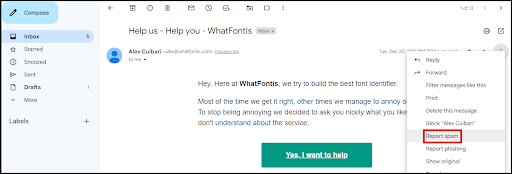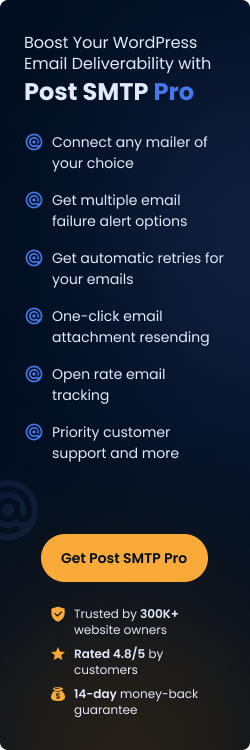Do your email campaigns have a low open rate? Or if you have no idea why your emails go into the spam folder, then you are not alone; according to Statista, almost 50% of emails go into the spam folder.
It’s no secret that spam emails are a major issue on the Internet, and that’s why email providers have implemented more strict policies to combat them.

In reality, a vast majority of emails that end up in the spam folder are spam. It would be inconvenient for individuals to sort through all of these emails manually, so Internet Service Providers (ISPs) and email services such as “Gmail” have implemented filters that prevent spam emails from reaching the inbox.
However, there are many other reasons or mistakes which can cause your legitimate emails to go into the spam folder. But don’t worry, in this article, we’ll discuss those reasons in detail and how you can avoid them by implementing recommended solutions.
So without further ado, let’s get started
Reasons Why Your Emails Go Into The Spam Folder
There are many reasons to explain why your emails go into the spam folder, such as a lack of email authentication, Spam-triggering keywords, bad links, etc.
So, keep reading to discover the 9 key reasons that cause your emails to go into the spam folder.
1. Lack of Email Authentication
Proper email authentication is essential to prevent emails from going into the spam folder. Unless the authentication is not set up correctly through any email autoresponder such as Mailchimp, GetResponse, etc., spam filters may mistakenly identify your legitimate emails as “junk emails” and throw them into the spam folder.
But fortunately, there are several email authentication protocols that you can utilize to avoid this problem, such as;
- Sender Policy Framework (SPF)
- DomainKeys Identified Mail (DKIM)
- Brand Indicators for Message Identification (BIMI)
- Domain-based Message Authentication, Reporting & Conformance (DMARC)
Authentication allows autoresponders to send emails on your behalf using your domain name. So, if you are experiencing difficulties with email deliverability, check the autoresponder email authentication settings first.
Note: Authentication setup varies between platforms, so consult the support team if you need assistance.
2. May Your Subscribers Mark Your Email As Spam
If you’ve got email authentication in place and are still facing the same issue, then there is a higher probability that your subscribers may mark your email as spam.
Even if you have permission from the recipient to contact them, your subscribers may mark your emails as spam to declutter their inboxes.

If many users mark your emails as spam, it may trigger spam filters to flag your email address automatically. Consequently, your emails will end up in the spam folder.
From the moment you send the email, you can’t do much to prevent it from being marked as spam. However, you can ensure that your email’s content is high quality which can minimize the risk of spam marks on your email.
3. Your Content Includes Spam Triggering Words & Phrases
If your emails contain particular words or phrases commonly associated with spam or unwanted emails, they may be considered spam and classified as spam. These are called “spam-triggering words and phrases.” Some examples of these types of words and phrases include;
- “Free” or “Free Trial,”
- “Make money fast” or “Earn extra cash.”
- “Additional Income,”
- “Work from home” or “Work at home”
- “Weight loss” or “Lose weight.”
- “Buy now” or “Order now.”
- “Easy Money” or “Fast Money”
- Unnecessary spaces or punctuation
- A series of exclamation marks or dollar signs
- Using All-CAPS words
- Emoji overload (Some are good, but not too many)
Spam filters use algorithms to scan the content of emails and look for these types of words and phrases.
So, avoiding spam-triggering words and phrases in your emails’ subject lines or body is a must. Instead, use clear and concise language that accurately describes the content of your email.
4. Email With A Missing Unsubscribe Link
Another reason why your emails go into the spam folder is if it does not include an unsubscribe link. According to CAN-SPAM Act, you must provide an “Unsubscribe Link” in your email that allows recipients to easily opt out of receiving future emails.

Additionally, including an unsubscribe link can help improve your emails’ deliverability because it demonstrates that you are following best email marketing practices and respecting your recipients’ preferences.
5. Your Physical Address Is Missing
Did you know that The Federal Trade Commission (FTC) requires all emails to include a valid postal address?
This can be your physical address, a post office box registered with the US Postal Service, or a private mailbox registered with a commercial mail-receiving agency. So, if you don’t provide this information in your email, it will be considered spam.
You can add your physical address at the bottom of your email right above the Unsubscribe link, as shown in the picture below;

If you work from home and need a physical address, getting a post office box for your business is a good idea. It will allow you to maintain a professional image and protect your privacy simultaneously.
In summary, include your physical postal address in your emails to avoid any issues with spam filters and maintain a professional image.
6. Email With A Misleading Subject Line
The subject line of an email is an important factor in determining whether or not the recipient will open the email. Therefore, it must be attention-grabbing and compelling to the reader. However, it also has to be authentic.
Otherwise, a misleading subject line can cause your email to end up in the spam folder. Here are a few examples of a misleading subject line to avoid;
- Use of RE or FW: It’s generally best to avoid starting a subject line with “RE” unless you answer or reply to an email. Similarly, using “FW” can give the impression that the recipient is already familiar with the content of the message, which could be misleading.
- Use of Personalized or Misleading Questions: Subjects lines like “Did I forget my jacket in your house?” or “Have you heard of this or that?” might make users wonder whether the sender is someone they know.
- Use of Extremely Bold Claims: A subject line like “Make Money Fast!” or “Free Money!” is likely to be a bold claim because scammers often use these subject lines to trick people into clicking on links or giving away personal information.
So, you need to be honest and straightforward in the subject line of your emails to avoid spam filters. By doing so, you will ensure that the intended recipient will receive and read your message.
7. Large Images With Little or No Text
In marketing, visuals, such as images and graphics, can effectively grab your audience’s attention. However, it’s important to strike the right balance between text and visuals in your emails.
Because an email containing a large image with a small text might trigger spam filters, causing the email to end up in the spam folder.
To avoid this, use a good balance of text and images in your emails. You can do this by using images to supplement your text rather than replacing it, using alt text to describe your images for accessibility, and keeping your images small in size to improve load times.
8. Your Emails Lack HTML Best Practices
Although emails with text-only content are relatively simple, but may not be suitable for certain businesses like eCommerce websites due to a lower engagement rate than those that include GIFs, images, branding, and other HTML-based design elements.
So, if you’re going to include HTML in your emails, keep a few things in mind to avoid them ending up in the spam folder. Based on Mailchimp’s recommendations, some of the best practices are as follows:
- Keep the width of your email between 600 and 800 pixels. This will make it easy to read and look good on client preview screens.
- Make sure your code is simple and lightweight, especially CSS. Additionally, do not use JavaScript or Flash, as these may trigger spam filters, and not all email clients support them.
- Remember that some email clients may block images, so don’t include critical information only in media elements.
- Be sure your emails are mobile-friendly. Use fonts and images which are responsive to mobile devices.
- When choosing fonts, opt for cross-platform ones that are easily readable, such as Arial, Georgia, and Verdana.
- Check any links in your email signature and avoid linking to spammy websites.
To increase the chances of your email deliverability, try to make your content as text-rich as possible and minimize your HTML content. You can still use your company branding and colors to engage readers without overdoing it.
9. Emails Containing Large or Multiple Attachments
It’s generally advisable to avoid sending attachments through email because they are commonly associated with malware and viruses and are more likely to trigger spam filters.
So, the best practice is to avoid including attachments completely, particularly in newsletters. However, if it’s necessary to send an attachment, it’s advisable to let the receiver know in advance and attach as few files as possible.
On the other hand, instead of attaching a file directly to your email, a good alternative is to upload it to a cloud storage provider like Dropbox or Google Drive and add the file link to your email body.
This way, you can avoid any issues with spam filters. Just make sure that the recipient has access to the file through the link you provide.
5 Quick Fixes To Why Your Emails Go Into The Spam Folder
Here are some quick fixes that you can follow to avoid your emails from going into the spam folder.
Fix#1: Enable Proper Email Authentication
As we mentioned early in the article that there are several email authentication protocols that you can utilize to authenticate your email address, like;
- Sender Policy Framework (SPF)
- DomainKeys Identified Mail (DKIM)
- Brand Indicators for Message Identification (BIMI)
- Domain-based Message Authentication, Reporting & Conformance (DMARC)
So, log in to any autoresponder you are using and set up the authentication now.
Fix#2: Follow Email Writing & Design Best Practices
After enabling email authentication, you’ll be fine. However, you must follow the best email writing practices to bypass spam filters, such as;
- Avoid Spam Triggering Words & Phrases: avoid using misleading subject lines, spam-triggering words like “Free Money” or “Fast Money” and similar phrases, check spelling and grammar, and don’t misuse punctuation or emojis.
- Keep Images To A Minimum: Keep the balanced image and text ratio in place. Also, include more text and HTML instead of images.
- Keep Attachments To A Minimum: only send attachments when necessary. Or use any 3rd party service like Google Drive, Dropbox, etc.
- Provide Accurate Sender Information: It includes your physical address or a PO Box address.
- Avoid adding shady website links: Include only trusted links that are safe for users.
Fix#3: Ask Your Subscribers To Whitelist Your Email
When sending a welcome email to your new subscribers, ask them to add you to their whitelist. This is simply your way of asking them to inform their email providers that you are not a spammer.
If you are just getting started, then now is the perfect time to tell your subscribers to whitelist. Doing so will increase your reputation as a sender, resulting in a higher email deliverability rate.
Fix#4: Use A Reliable WP Mail SMTP
If you are still facing the same issue, we recommend using a reliable WP Mail SMTP plugin such as Post SMTP. It will improve the email deliverability for your WordPress website.
It’s easy to use, and over 300,000+ customers trust Post SMTP daily to send emails to millions of people. Also, with this, you don’t have to configure everything; the team will do everything for you. All you need is to create the email and click send.
Furthermore, Post SMTP ensures that your emails are fully authenticated and sent via trusted third parties. Doing this will prevent your email campaigns from being mistakenly classified as spam.
Fix#5: Use Spam Tester/Checker To Identify The Issue
After implementing all of the recommended strategies and still experiencing difficulty with your emails being flagged as spam, then worry not; several spam checkers available can help you identify any problems with your emails.
Here are a few examples:
- Mail-Tester
- Litmus
- IsNotSpam.com
These spam checkers help you check email authentication, give you a spam score, tell you how to improve it, etc.
Final Thoughts
To put it simply, there are various key reasons why your emails go into the spam folder, for example, a weak subject line or the use of spam-triggering keywords, etc. Thus, fixing these issues will help you increase ROI and keep and keep your audience happy.
The sooner you address these problems and implement the best practices, the less likely your emails will end up in the spam folder. Not only will it increase your email deliverability. But it can also enhance its impact and turn your subscribers into paying customers.



